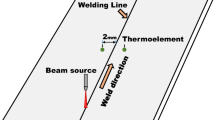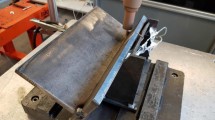Abstract
Electron beam welding (EBW) is widely used to connect thin-walled high-temperature alloy structures in aeroengines. However, the residual stress and deformation caused by the high-temperature gradients generated during welding would affect the rigidity, dimensional stability, and fatigue resistance of the welded structures. The study reported here used a model combining ellipsoidal and Gaussian rotating body heat sources to undertake a numerical simulation of the temperature and residual stress generated during the EBW process. The model was systematically refined by observing and measuring the molten pool morphology. The error rates for key dimensions determining the molten pool shape were less than 6%. With a microscope-based examination, the energy distribution characteristics were detected by the microstructure analysis of grain type and size in different regions to verify the viability of the heat source model. The residual stress of a butt welding was simulated by the proposed heat source model based on the full consideration of a full-loop thin-walled combustor casing structure and material properties. It was found that the average errors for longitudinal and transverse residual stresses of welded joints and their adjacent areas were 10% and 12%, respectively, by comparing with the experimental results. Simultaneously, the low cycle fatigue life of the welded combustor casing would be decreased by 32% considering the influence of welding residual stress. These conclusions can be used as a basis for studying the integrity of thin-walled welded structures in aeroengines.
















Similar content being viewed by others

References
Qu S, Li Y, Ni JC, Yang S, Zhou GN (2015) Application of advanced welding technology in aeroengine. Aeronaut Manuf Technol 58(20):53–55 http://www.amte.net.cn/CN/10.16080/j.issn1671-833x.2015.20.053. http://www.amte.net.cn/CN/article/downloadArticleFile.do?attachType=PDF&id=571
Zhang L, Han XF, Wang L (2015) Welding process analysis of disk and shaft rotor component of commercial aeroengine. Aeronautical Manufacturing Technology 480(11):96–98 http://www.amte.net.cn/CN/10.16080/j.issn1671-833x.2015.11.096. http://www.amte.net.cn/CN/article/downloadArticleFile.do?attachType=PDF&id=345
Zhang L, Han XF, Wang L (2016) Application of welding process in commercial aeroengine. Weld Join 8:54–59 http://www.wanfangdata.com.cn/details/detail.do?_type=perio&id=hj201608012
Liu D, Zhou WB, Sun HB, Song J, Wu Q (2019) Residual stress field evaluation of the blank of a casing part. In IOP Conference Series: Materials Science and Engineering (Vol. 612, No. 3, p. 032168). IOP Publishing. https://iopscience.iop.org/article/10.1088/1757-899X/612/3/032168/meta. https://iopscience.iop.org/article/10.1088/1757-899X/612/3/032168/pdf
Jha AK, Arumugham S (2001) Metallographic analysis of embedded crack in electron beam welded austenitic stainless steel chemical storage tank. Eng Fail Anal 8(2):157–166. https://doi.org/10.1016/S1350-6307(00)00003-0
Zhan XH, Wu YF, Kang Y, Liu X, Chen XD (2019) Simulated and experimental studies of laser-MIG hybrid welding for plate-pipe dissimilar steel. Int J Adv Manuf Technol 101(5–8):1611–1622. https://doi.org/10.1007/s00170-018-3066-7
Węglowski MS, Błacha S, Phillips A (2016) Electron beam welding–techniques and trends–review. Vacuum 130:72–92. https://doi.org/10.1016/j.vacuum.2016.05.004
Pavelic V, Tanbakuchi R, Uyehara OA, Myers PS (1969) Experimental and computed temperature histories in gas tungsten-arc welding of thin plates. Weld J Res Suppl 48:296–305 https://ci.nii.ac.jp/naid/10018019515/
Goldak J, Chakravarti A, Bibby M (1984) A new finite element model for welding heat sources. Metall Mater Trans B Process Metall Mater Process Sci 15(2):299–305. https://doi.org/10.1007/BF02667333
Bardel D, Nelias D, Robin V, Pirling T, Perez M (2016) Residual stresses induced by electron beam welding in a 6061 aluminium alloy. J Mater Process Technol, 235. https://doi.org/10.1016/j.jmatprotec.2016.04.013
Wang YJ, Fu PF, Guan YJ, Lu ZJ, Wei YT (2013) Research on modeling of heat source for electron beam welding fusion-solidification zone. Chin J Aeronaut 26(1):217–223. https://doi.org/10.1016/j.cja.2012.12.023
Wang JQ, Han JM, Domblesky JP, Yang ZY, Zhao YX, Zhang Q (2016) Development of a new combined heat source model for welding based on a polynomial curve fit of the experimental fusion line. Int J Adv Manuf Technol 87(5–8):1985–1997. https://doi.org/10.1007/s00170-016-8587-3
Gratkowski S, Brykalski A, Sikora R, Ziolkowski M, Brauer H (2009) Modelling of Seebeck effect in electron beam deep welding of dissimilar metals. COMPEL. https://doi.org/10.1108/03321640910918940
Petrov P, Tongov M (2020) Numerical modelling of heat source during electron beam welding. Vacuum 171:108991. https://doi.org/10.1016/j.vacuum.2019.108991
Ferro P, Zambon A, Bonollo F (2005) Investigation of electron-beam welding in wrought Inconel 706--experimental and numerical analysis. Mater Sci Eng A 392(1):94–105. https://doi.org/10.1016/j.msea.2004.10.039
Maurer W, Ernst W, Rauch R, Kapl S, Pohl A, Krüssel T, Vallant R, Enzinger N (2012) Electron beam welding of Atmcp steel with 700 mpa yield strength. Weld World 56(9–10):85–94. https://doi.org/10.1007/BF03321384
Sun Z, Karppi R (1996) The application of electron beam welding for the joining of dissimilar metals: an overview. J Mater Process Technol 59(3):257–267. https://doi.org/10.1016/0924-0136(95)02150-7
Venkata KA, Truman CE, Smith DJ, Bhaduri AK (2016) Characterising electron beam welded dissimilar metal joints to study residual stress relaxation from specimen extraction. Int J Press Vessel Pip 139:237–249. https://doi.org/10.1016/j.ijpvp.2016.02.025
Smith DJ, Zheng G, Hurrell PR, Gill CM, Pellereau BME, Ayres K, Goudar D, Kingston E (2014) Measured and predicted residual stresses in thick section electron beam welded steels. Int J Press Vessel Pip 120-121:66–79. https://doi.org/10.1016/j.ijpvp.2014.05.001
Lacki P, Adamus K, Wieczorek P (2014) Theoretical and experimental analysis of thermo-mechanical phenomena during electron beam welding process. Comput Mater Sci 94:17–26. https://doi.org/10.1016/j.commatsci.2014.01.027
Elliott S (1984) Electron beam welding of C--Mn steels--toughness and fatigue properties. Weld J 63(1):8 https://app.aws.org/wj/supplement/WJ_1984_01_s9.pdf
Li XB, Lu FG, Cui HC, Tang XH, Wu YX (2014) Numerical modeling on the formation process of keyhole-induced porosity for laser welding steel with T-joint. Int J Adv Manuf Technol 72(1–4):241–254. https://doi.org/10.1007/s00170-014-5609-x
Tsirkas SA, Papanikos P, Pericleous K, Strusevich N, Boitout F, Bergheau JM (2003) Evaluation of distortions in laser welded shipbuilding parts using local-global finite element approach. Sci Technol Weld Join 8(2):79–88. http://gala.gre.ac.uk/id/eprint/626. https://doi.org/10.1179/136217103225010899
Carmignani C, Mares R, Toselli G (1999) Transient finite element analysis of deep penetration laser welding process in a singlepass butt-welded thick steel plate. Comput Methods Appl Mech Eng 179(3–4):197–214. https://doi.org/10.1016/S0045-7825(99)00043-2
Luo X, Shinozaki K, Kuroki H, Yoshihara S, Okumoto Y, Shirai M (2002) Analysis of temperature and elevated temperature plastic strain distributions in laser welding HAZ study of laser weldability of Ni-base superalloys (report 5). Weld Int 16(5):385–392. https://doi.org/10.1080/09507110209549547 https://www.tandfonline.com/doi/pdf/10.1080/09507110209549547
Chen GQ, Liu JP, Shu X, Gu H, Zhang BG (2019) Numerical simulation of keyhole morphology and molten pool flow behavior in aluminum alloy electron-beam welding. Int J Heat Mass Transf 138:879–888. https://doi.org/10.1016/j.ijheatmasstransfer.2019.04.112
Evdokimov A, Springer K, Doynov N, Ossenbrink R, Michailov V (2017) Heat source model for laser beam welding of steel-aluminum lap joints. Int J Adv Manuf Technol 93(1–4):709–716. https://doi.org/10.1007/s00170-017-0569-6
Nyon KY, Nyeoh CY, Mokhtar M, Abdul-Rahman R (2012) Finite element analysis of laser inert gas cutting on Inconel 718. Int J Adv Manuf Technol 60(9–12):995–1007. https://doi.org/10.1007/s00170-011-3655-1
Hou ZL, Zhao T, Xu Z, Zhu LH, Sun JH, Jin YH, Lv XZ (2019) The new heat source model of AZ31B magnesium alloy laser-TIG hybrid welding. In Key engineering materials (Vol. 815, pp. 120-124). Trans Tech Publications Ltd. https://doi.org/10.4028/www.scientific.net/KEM.815.120
Zhang LW, Pei JB, Zhang QZ, Liu CD, Zhu WH, Qu S, Wang JH (2007) The coupled FEM analysis of the transient temperature field during inertia friction welding of GH4169 alloy. Acta Metall Sin (Eng Lett) 20(4):301–306. https://doi.org/10.1016/S1006-7191(07)60043-X
Geng PH, Qin GL, Zhou J (2020) A computational modeling of fully friction contact-interaction in linear friction welding of Ni-based superalloys. Mater Des 185:108244. https://doi.org/10.1016/j.matdes.2019.108244
Cook PS, Murphy AB (2019) Simulation of melt pool behaviour during additive manufacturing: underlying physics and progress. Addit Manuf 100909. https://doi.org/10.1016/j.addma.2019.100909
Agnoli A, Bernacki M, Logé R, Franchet JM, Laigo J, Bozzolo N (2015) Selective growth of low stored energy grains during δ sub-solvus annealing in the Inconel 718 nickel-based superalloy. Metall Mater Trans A 46(9):4405–4421. https://doi.org/10.1007/s11661-015-3035-9
Withers PJ, Bhadeshia HKDH (2001) Residual stress. Part 1–measurement techniques. Mater Sci Technol 17(4):355–365. https://doi.org/10.1179/026708301101509980
Withers PJ, Bhadeshia HKDH (2001) Residual stress. Part 2–nature and origins. Mater Sci Technol 17(4):366–375. https://doi.org/10.1179/026708301101510087
Pu XW, Zhang CH, Li S, Deng D (2017) Simulating welding residual stress and deformation in a multi-pass butt-welded joint considering balance between computing time and prediction accuracy. Int J Adv Manuf Technol 93(5–8):2215–2226. https://doi.org/10.1007/s00170-017-0691-5
Brünnet H, Bähre D, Rickert T, Dapprich D (2014) Modeling and measurement of residual stresses along the process chain of autofrettaged components by using FEA and hole-drilling method with ESPI. In Materials Science Forum (Vol. 768, pp. 79-86). Trans Tech Publications Ltd. https://doi.org/10.4028/www.scientific.net/MSF.768-769.79
Manson SS (1953) Behavior of materials under conditions of thermal stress (Vol. 2933). National Advisory Committee for Aeronautics. https://ntrs.nasa.gov/search.jsp? R=19930092197. http://hdl.handle.net/2060/19930083626
Coffin LF Jr (1954) A study of the effects of cyclic thermal stresses on a ductile metal. Trans Am Soc Mech Eng New York 76:931–950 https://ci.nii.ac.jp/naid/10012801028/
Wollmann J, Dolny A, Kaszuba M, Gronostajski Z, Gude M (2019) Methods for determination of low-cycle properties from monotonic tensile tests of 1.2344 steel applied for hot forging dies. Int J Adv Manuf Technol 102(9–12):3357–3367. https://doi.org/10.1007/s00170-019-03349-2
Author information
Authors and Affiliations
Corresponding author
Ethics declarations
Conflict of interest
We wish to draw the attention of the Editor to the following facts which may be considered as potential conflicts of interest and to significant financial contributions to this work.
We confirm that the manuscript has been read and approved by all named authors and that there are no other persons who satisfied the criteria foe authorship but are not listed. We further confirm that the order of authors listed in the manuscript has been approved by all of us.
We understand that the corresponding author is the role contact for the editorial process (including Editorial Manager and direct communications with the office). She is responsible for communicating with the other authors about progress, submissions of revisions, and final approval of proofs. We confirm that we have provided a current, correct email address which is accessible by the corresponding author and which has been configured to accept email from The International Journal of Advanced Manufacturing Technology.
Additional information
Publisher’s note
Springer Nature remains neutral with regard to jurisdictional claims in published maps and institutional affiliations.
Highlight
Advanced application background: Design and manufacture of high thrust-weight ratio aeroengines.
Advanced materials for aeroengines: Nickel-base high-temperature alloy (GH4169).
Advanced welding technology: Electron beam welding, a combined ellipsoidal and Gaussian rotating body heat source model.
Application background: Thin-walled welded structures in aeroengines, a full-loop combustor life prediction.
Research method: Numerical modeling, experimental verification, combination of macroscopic and microscopic analysis.
Rights and permissions
About this article
Cite this article
Shen, X., Gao, K. & Dong, S. Simulation and analysis of electron beam welding residual stress in thin-walled high-temperature alloy aeroengine structures. Int J Adv Manuf Technol 107, 3953–3966 (2020). https://doi.org/10.1007/s00170-020-05276-z
Received:
Accepted:
Published:
Issue Date:
DOI: https://doi.org/10.1007/s00170-020-05276-z



